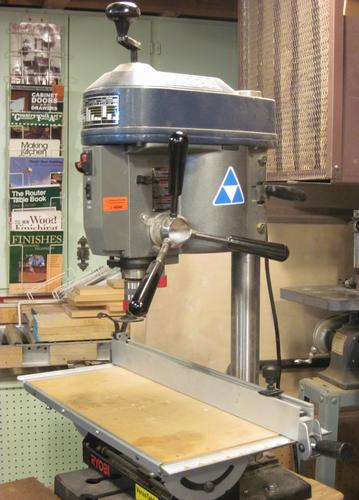
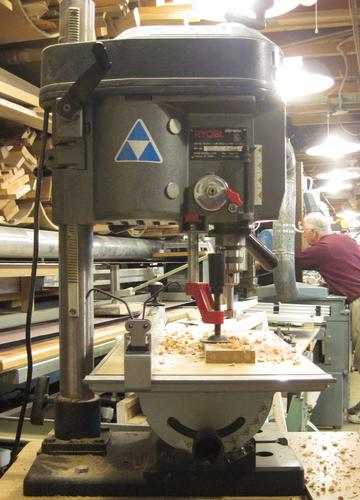

| 
|
One of the intriguing things I saw in Jacques's workshop was his Ryobi WDP 850 drill press. It's an odd looking drill press, but definitely worth a second look. So I visited Jacques again and had a closer look.
This drill press was sold by Ryobi some years back, but it's discontinued now. It's a drill press that is more designed for wood, and it addresses some of the annoyances with typical drill presses.
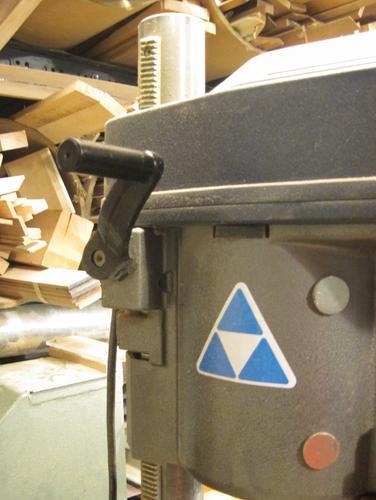 A key difference from regular drill presses is that instead of moving the table up and down,
this drill press moves the motor and everything. This has a number of advantages. It means that the
drill table doesn't need to move up and down along the column. This makes it easier to have a
large table. Also, with the drill table fixed in position, it's much easier to support large
stock away from the table. Another advantage is that the table is always close to
the workbench surface, so that most of the time you are working close to the bench, so
it's not awkward to use it on a higher workbench.
A key difference from regular drill presses is that instead of moving the table up and down,
this drill press moves the motor and everything. This has a number of advantages. It means that the
drill table doesn't need to move up and down along the column. This makes it easier to have a
large table. Also, with the drill table fixed in position, it's much easier to support large
stock away from the table. Another advantage is that the table is always close to
the workbench surface, so that most of the time you are working close to the bench, so
it's not awkward to use it on a higher workbench.
Another difference compared to conventional drill presses is that the motor is in front of the column. This puts the column a bit further away, which gives you more room in front of it - something I wish my drill press had. I had to use a hand drill to drill the holes in the wheels of my homemade bandsaws. With the motor in front of the column, this drill press can also be pushed right up against a wall.
The drill press also has a continuously variable speed adjustment with a crank on top for setting the speed. I wish my drill press had that. Though, really, this improvement is also available on the better conventional drill presses.
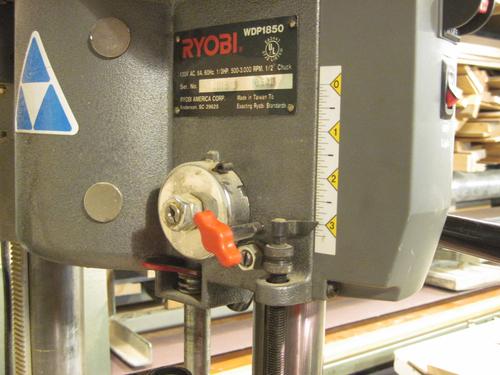 The drill press quill travels up and down by just over three inches (about 8 cm). Nothing unusual
about that. It has a linear depth stop and scale on the left, but also the rotary form of depth
stop on the right. I'm no big fan of the linear depth stops myself - the rotary ones are much
quicker to set, but this drill press gives you a choice.
The drill press quill travels up and down by just over three inches (about 8 cm). Nothing unusual
about that. It has a linear depth stop and scale on the left, but also the rotary form of depth
stop on the right. I'm no big fan of the linear depth stops myself - the rotary ones are much
quicker to set, but this drill press gives you a choice.
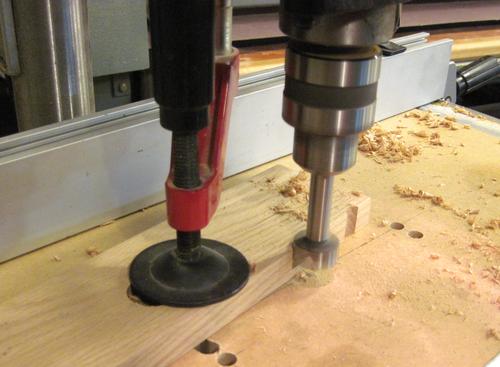 The drill press also has this built in clamp, which sort of comes down like a foot
right next to the drill press chuck. It seems like a bit of a gimmick, but that clamp, because
it's attached head of the drill, sort of acts like a foot connecting the upper part right
to the stock, so it really helps steady everything.
The drill press also has this built in clamp, which sort of comes down like a foot
right next to the drill press chuck. It seems like a bit of a gimmick, but that clamp, because
it's attached head of the drill, sort of acts like a foot connecting the upper part right
to the stock, so it really helps steady everything.
Then again, with a generously sized drill press table on this drill press, and with the table close to the work bench, it would be much harder to clamp your work piece to the table with bar clamps or C clamps. And with the column further back, and the table not attached directly to the column, this drill press is slightly less rigid than conventional drill presses. But the clamp makes up for that quite nicely.
I'm drilling a hole only partially in the wood with a large forstner bit in this photo and it drilled cleanly with no vibrations.
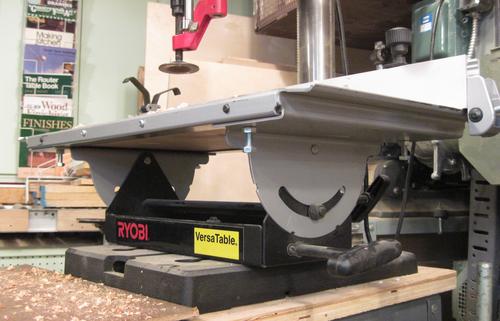 The drill press came with this "VersaTable". The versaTable looks a little flimsy, but
then again, it doesn't have to cantilever out from the column like a normal drill press table
does. Testing the drill press, the table seemed rigid enough. And if it isn't,
you can always take it off and work directly on the base.
The drill press came with this "VersaTable". The versaTable looks a little flimsy, but
then again, it doesn't have to cantilever out from the column like a normal drill press table
does. Testing the drill press, the table seemed rigid enough. And if it isn't,
you can always take it off and work directly on the base.
It is much easier to set the angle on the VersaTable than on a regular drill press table. On my chap drill press it's so awkward that, I make sure the table is dead square and then I never adjust it. If I need to drill an angled hole, I make a wedge of the appropriate angle to support the stock.
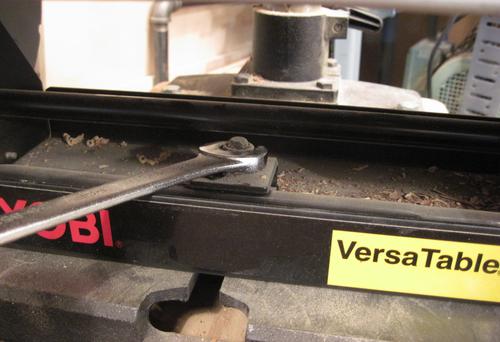 The VersaTable is held down by a bolt in the middle. With a slot in the base, and a
slot in the table, there's quite a bit of freedom in positioning this table.
On a regular drill press, the table tilts only one way, and it's not unlikely
that you'd hit the drill press column with your stock for some angles.
The VersaTable is held down by a bolt in the middle. With a slot in the base, and a
slot in the table, there's quite a bit of freedom in positioning this table.
On a regular drill press, the table tilts only one way, and it's not unlikely
that you'd hit the drill press column with your stock for some angles.
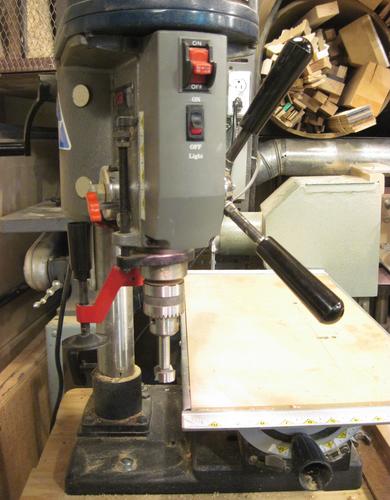 I often end up drilling near or off the edge of the table on my drill press for some operations,
like drilling in the end of a piece of wood, for example.
This is something the WDP would not be as good at, although the head can be swivelled
to the side. But the VersaTable is probably not ideal for drilling off the edge. Also, with the
table so close to the bench, that limits the options.
I often end up drilling near or off the edge of the table on my drill press for some operations,
like drilling in the end of a piece of wood, for example.
This is something the WDP would not be as good at, although the head can be swivelled
to the side. But the VersaTable is probably not ideal for drilling off the edge. Also, with the
table so close to the bench, that limits the options.
Overall though, I think this drill press is an improvement over conventional drill presses used in wood shops. It was discontinued years ago. So why didn't this drill press take over the market?
Jacques says that in the three years that he worked at The Home Depot, they sold only one of these, and that was the one he bought in 2000. Part of the problem was probably the price, which was $699. I imagine another problem was that people didn't recognize just how this was a better drill press. I think on the whole, we get too caught up with "old must be better" - it's like we are obsessed with old pieces of cast iron.
But I have to admit, I wouldn't have bought this drill press either. With conventional drill presses of comparable size but lesser quality selling for about a quarter of the price, it's hard to justify the difference for a better drill press, especially if that drill press also involves some compromises.
See also:
My homemade horizontal boring machine
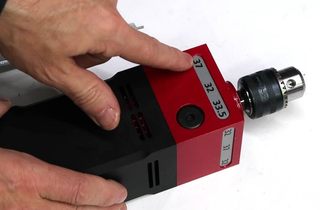 A square drill for round holes
A square drill for round holes